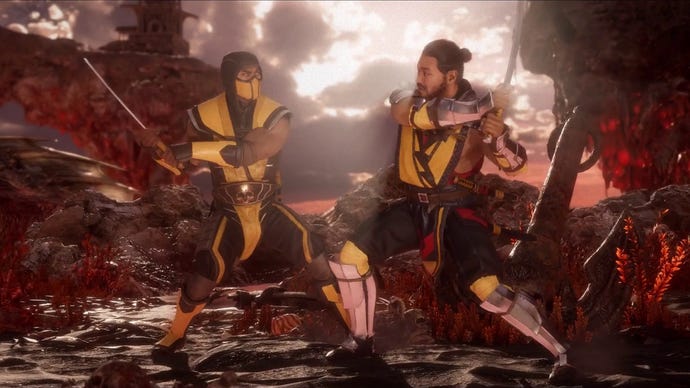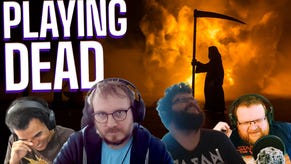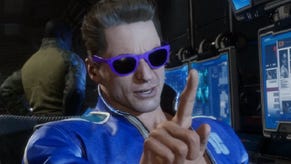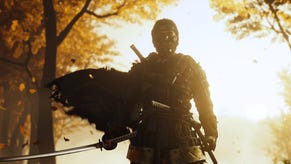Mortal Kombat 11 Review
What happens when you're locked in Mortal Kombat with yourself?
This article first appeared on USgamer, a partner publication of VG247. Some content, such as this article, has been migrated to VG247 for posterity after USgamer's closure - but it has not been edited or further vetted by the VG247 team.
It's amazing how far Mortal Kombat has come since the original arcade contender released way back in 1992. A title originally presented with digitized sprites based on real actors now features fully 3D models in stunning and gory anatomical detail. Even while its rival stumbles a bit, Netherrealm feels like it moves from strength-to-strength as it alternates between Mortal Kombat and the DC Comics-based Injustice series.
Mortal Kombat 11 lives up to those strengths for the most part, stumbling only under the weight of live service design decisions.
Get Over Here!
Netherrealm's latest continues the continuity wrought by 2011's soft reboot of the series. You get a roster of 25 fighters from day one, assuming you pre-ordered to get formerly-dead warlord Shao Khan. This includes series mainstays like Scorpion, Sub-Zero, and Liu Kang, alongside returning fighters like Baraka and Kabal. You get a few brand-new fighters like the four-armed Kollector, time-shifting colossus Geras, and Cetrion, the elemental-wielding goddess of virtue. There are also a few fighters who are in as combatants, but aren't selectable in the roster, so I assume they'll be coming in downloadable content of some sort.
Every character has their own core mechanics that makes them stand out from the rest. Jax is back and successive melee attacks will heat up his metal arms, causing him to deal additional damage; you want to keep the pressure on the opponent to keep your damage high. Skarlet's blood special moves appear out of thin air, allowing you to push enemies out and keep them far away. Her attacks can also be amplified to heal her. Baraka has his new War Banner, which increases his damage for a short period of time. There's a lot of character variety here, and that's before you get into Variations.
Variations allow you to play around with each character's special attacks. A character has a consistent set of abilities, but you can also augment these abilities or add new ones within the Kustomization menu. For example, Scorpion comes standard with his Spear and Hell Port special moves, but you can also swap in his Hell Flame fireball, close-range Demon Breath, or Burning Spear, which lights the spear itself on fire. Every character has a total of three ability slots, with certain abilities taking up a single slot and others taking up two. Netherrealm has set up two default variations for every character just to get you in the swing of things, but you can create your own.
25 characters and a whole host of variations is a big ocean for new players to jump into, but Netherrealm made sure that Mortal Kombat 11 is still accessible. There is an extensive playable Tutorial section that not only covers basic moves, but also advanced offense and defense techniques, fight strategy for positioning and pressure, and even character-specific lessons to give you a taste of their mechanics. Jump into practice and there's options for recording moves and changing AI, backed by a move list that lists specific damage and detailed frame data information. There's even a dedicated mode for practicing fatalities! I don't think I've seen a fighting game that's more new player friendly than Mortal Kombat 11.
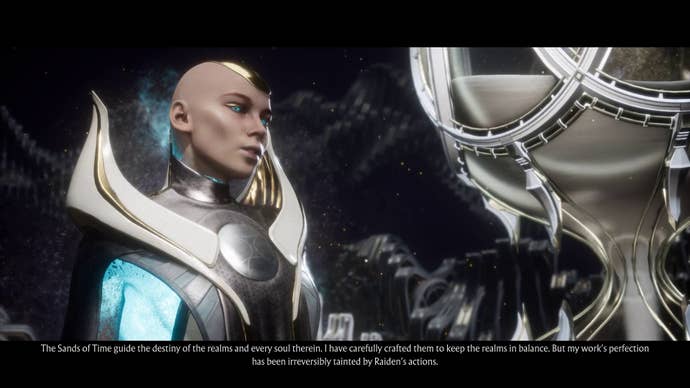
Re-Canonized
One part that Mortal Kombat 11 absolutely nails is the Story mode. It's interesting that the same week that Marvel Studios ends its lengthy storytelling experiment with Avengers: Endgame, Neatherrealm tries to do something similar with Mortal Kombat. Mortal Kombat 11 has a lengthy story mode, heavy on the cinematics. It spans twelve chapters of various length and checks in on most of the major Mortal Kombat cast in one way or another.
Tired of Raiden's time-based meddling back in 2011's Mortal Kombat soft reboot, Kronika, Keeper of Time, is seeking to set things right. 'Right' for her means changing time to remove Raiden and restore balance, with light and dark warring across all realms forever. To this end, Kronika brings the heroes and villains of the past forward in time, hoping to gather forces and keep everyone confused while she enacts her plan.
This basically brings back "classic" versions of the Mortal Kombat cast and presents them with their current counterparts. Sonya Blade has to deal with the fact that she has a daughter with Johnny Cage, Johnny Cage is confronted with his old diva self, and Liu Kang, Kung Lao, and Kitana come face-to-face with their current status as undead warlords. Probably one of the best moments is restored human Scorpion, faced with his younger demon self, who is still consumed with anger and hate.

If you've been following these characters even a little bit, it's a grand adventure for the entire cast. It's Mortal Kombat, so most of the story is nonsense, but it's equal part nonsense and grandeur. These feel like epic, meaningful moments, even for someone like myself who only tangentially follows this continuity. And it's all delivered with fantastic cinematic cutscenes that comprise most of the 4 - 5 hour runtime of the Story mode. No one else delivers fighting game stories like Netherrealm; the closest I've seen in terms of scope and fan service is perhaps Dragon Ball FighterZ, and MK 11 still beats it.
There's a canon definitive ending to Story mode that opens up a new path for the series, but there are also smaller non-canon character endings available at the end of the Klassic Towers mode. This is essentially an old-school Arcade mode, where you pick a character and tackle straightforward fights against the AI. Klassic Towers comes in five flavors: Novice, Warrior, Champion, Endless, and Survivor. Each offers a different number of encounters, with Endless stretching on as long as you can survive and Survivor giving you one life bar for 25 fights. The character endings don't have the same presentation as the full Story Mode, being only hand-drawn art, but they provide fun little 'what ifs' for each character. (Jax's ending is a ballsy move.)
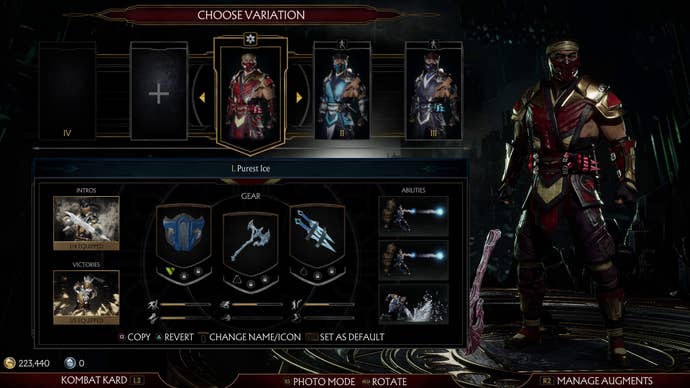
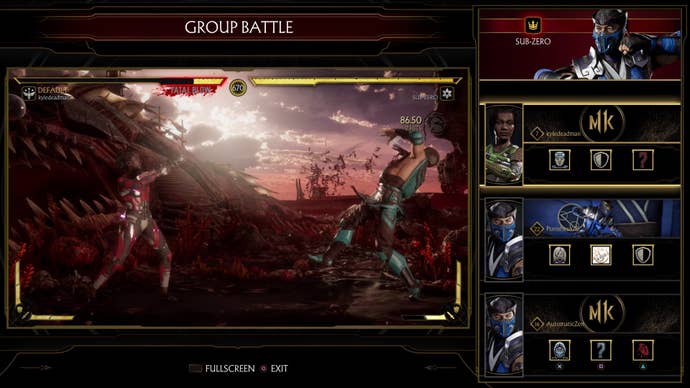
Kustomization Kuts to the Kore
I was very big on Mortal Kombat 11 in the early hours. Up until a certain point, it's a fantastic game well in-line with Injustice 2. Unfortunately, there are some other alternate modes of play that are here to lengthen your time with MK 11, and they cause the game to descend into tedium.
At the core of all this tedium is the Kustomization system. Like Injustice 2, each character has gear, down to three slots from that game's five. Unlike Injustice 2, the gear is semi-cosmetic: it only changes your appearance in small ways, while larger changes come from full character skins. Every character has 60 skins in total, which breaks down to 4-5 different looks with a number of color variants. In addition to the abilities I mentioned before, you can change literally everything about your favorite characters: gear, skins, fight intros, and victory cinematics. All of that, including fatalities and brutalities, needs to be unlocked though.
You'll unlock most of this stuff in two modes: The Towers of Time or The Krypt. Let's start with Towers of Time, Mortal Kombat 11's version of Injustice 2's Multiverse. Like that mode, you're faced with a series of challenge towers that change daily. The randomized towers have a different number of encounters, varying difficulty, and certain modifiers that make the battles harder. These modifiers include stage weapons that target you, increased elemental damage (usually favoring whoever you're fighting), and even the ability to call in other fighters.

There's a few problems. First, you can't see what the modifiers actually do without jumping into the tower itself, which seems like an oversight. Second, the modifiers are aimed in your direction, rather than being something that affects all fighters on the battlefield. If there's random blood missiles as a modifier, they're only after you. You're meant to combat these modifiers with Konsumables, single-use items you win from various game modes. These items allow you to gain health and armor, or negate certain elemental damage on command. You'll eventually have a stockpile of them and part of fighting towers is figuring out which konsumables you should be taking into a fight with you.
Modifiers don't really feel challenging, instead they come across as cheap speedbumps in your path. (And combined with spikes in AI difficulty, you can find yourself getting bodied hard in some situations.) Take Dark Aura, which blacks out the screen if you're in melee range of the opponent. There's little strategy to counteracting that in terms of play. It doesn't really trip up the AI, and it's mostly there to annoy you and potentially get you to use the konsumable that counteracts the effect. There's a ton of konsumables to pick up, probably one for every type of modifier and element type. Super Smash Bros Ultimate recently tried something similar with its World of Light campaign mode, but I think that system was far more simple and elegant overall.
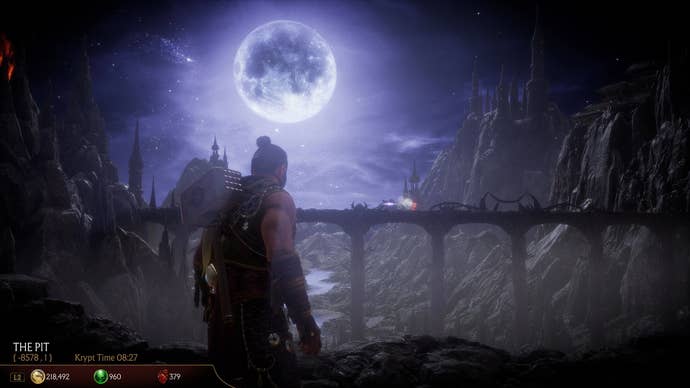
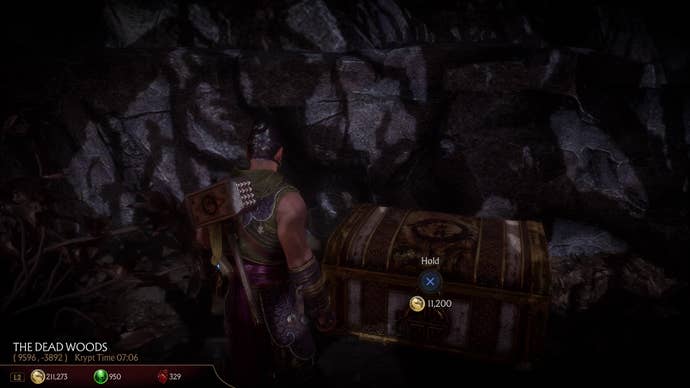
Krypt Keeper
Then there's the Krypt, which feels really cool on the surface. It's basically a full recreation of Shang Tsung's island from the first Mortal Kombat. You're a nameless warrior wandering across the island looking for treasure. The locale is presented in full 3D, with certain spots evoking levels and locations from the first game. It's kind of cool for the first time you come across the famous bridge level and see two warriors (Rain and Blaze?) fighting it out in the background.
But again, the tedium. Every single chest in the Krypt requires Koins, the basic currency in Mortal Kombat 11, to open. The amount of coins needed varies anywhere from around 1,500 to 15,000 Koins to unlock. And what you get inside each chest seems random. Opening chests for Koins is what the Krypt really breaks down to. There's some simple puzzles and exploration, but no real depth to the mode. Open chests that are littered everywhere as your currency allows, and use the few widgets you find to open the next path forward. It's almost a mobile game, to be honest.
And here's the thing, it's mostly random what you get from both modes. If you're a big fan of Erron Black, there's only a few ways to focus on just getting stuff for him. You can get a freebie skin for taking on his character tutorial, and you can spend 25,000 Koins to unlock a platform of towers in Towers of Time just for that character. Otherwise, you're flailing in the dark, hoping the right character-specific Tower spawns or you luck into a skin in the Krypt. But there's so many things that drops: skins, concept art, music, intros, victories, fatalities, brutalities, character icons, konsumables, augments, and even random bits for the Forge.
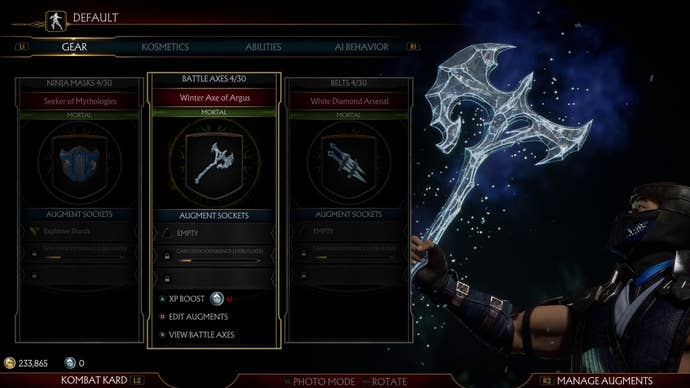
Augmenting the Grind
Augments only make this worse. Those three pieces of gear I mentioned for each character? There's a whole progression system behind them. Each of the three pieces of gear a character can equip can level up, with each new level opening up a new augment slot. These slots allow you to equip augments that give you bonuses and improve your abilities. They're a decent idea made convoluted.
See, augments also drop at random, in five different types: Soul, Netherflame, Order, Chaos, and Dragon Blood. When you level up a piece of gear, the augment slot you unlock will be one of these types as well. So if you have a Hat for Raiden, once you unlock the first augment slot—by equipping that piece of gear and using it in fights—it might be a Dragon Blood slot, but you've only received Soul and Order augments. Plus, those augments have to be for A) Raiden and B) Raiden's Hat. You're trying to fit two pieces of a puzzle together, but they're both pulled out of a box at random.
But wait, there's more! You've only leveled up that single hat. Raiden has 30 different hats and you have to level each one on its own. You can unequip an augment, but that costs 1,000 Koins. So for one character, you have three gear slots with 30 different pieces per slot, gained at random. Each piece of gear levels on its own, with random slots for specific types of augments, which also drop at random for any character.
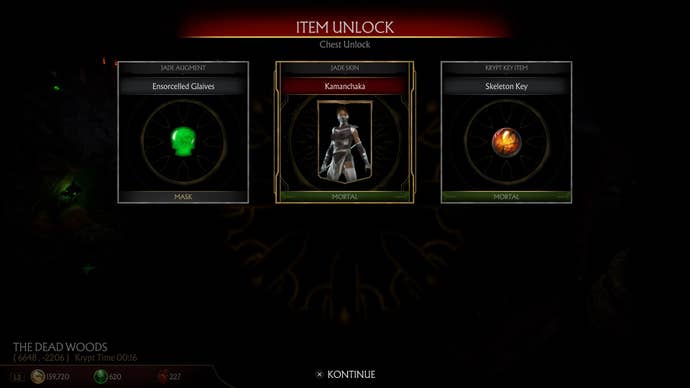
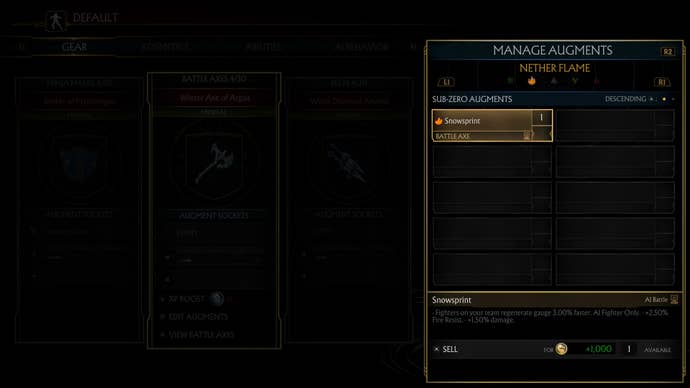
I just dinged Dead or Alive 6 for its unlock system (which the developer improved post-launch) and Mortal Kombat 11's is much worse. Even if they had gone back to Injustice 2's system, with Mother Boxes dropping random loot for every character in the game, it would've been better than this. That was at least straightforward.
Mortal Kombat 11 is fighting itself. In addition to Koins there are at least four other different currencies, like Time Krystals, Hearts, Soul Fragments, Tower Skip Tokens, and XP Boosts Tokens for each gear item. I can't even give you the full scope of currencies, because some of them either aren't available or don't do anything until launch.
Mortal Kombat 11 is a fantastic game that I had a ton of fun with, until I got to all of the extra stuff there to pad out the time played. Progression is fine, but progression in fighting game should be relatively straightforward. If I like Jacqui Briggs, make it easy, fun, and rewarding to play Jacqui Briggs. Make it simple to keep getting stuff for the character I like. Instead, you pay 25,000 Koins to get a character-specific tower, with the same annoying modifiers of any other tower, that may or may not give you the gear, augment, or skin you want.
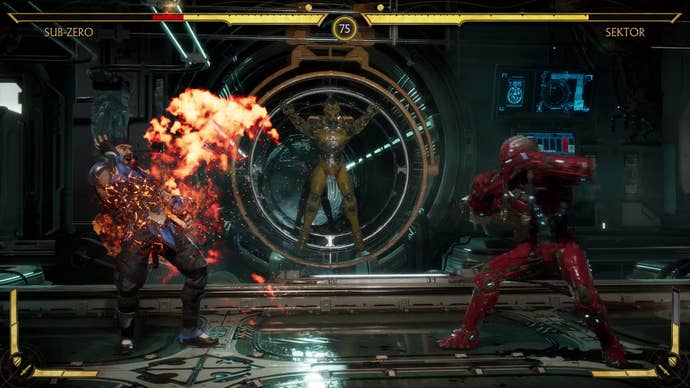
There's a wonderful level of craft here, and you can tell Netherrealm absolutely loves these characters. The levels are gorgeous, the characters are wonderfully detailed, and it's amazing what the studio can do with Fatalities. Not only is the story mode top-notch and the best in the business, there's also a bunch of smaller details, like the extensive amount of pre-fight dialogue that plays on past relationships. I actually like the idea of Variations and allowing players to unlock so many customizable parts and skins, especially since the artists clearly went to town on some of these looks.
But it's all obfuscated by progression systems that are too obtuse and complex. The Towers of Time and Krypt are so full of grind, padding, and additional currency that it simply sucks all the fun out of playing to unlock more for your favorite character. And though there's no store up in my review version, I have to assume those design decisions were made in favor of monetization and microtransactions. Which is a shame, because it's akin to Mortal Kombat 11 performing a Fatality on itself.
ConclusionThere's a lot to love in Mortal Kombat 11. It's a fantastic fighter with a roster of 25 varied characters, tons of customization options, beautiful graphics, and one of the best story modes in a fighting game. It's a shame that modes like the Krypt and Towers of Time inject annoyance and tedium into what was an excellent experience. The progression is complex and obtuse, when it should be easy and straightforward. MK 11 could been an all-time best, but it's just a contender.
